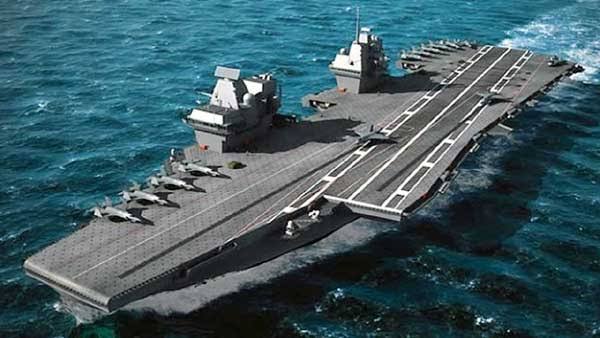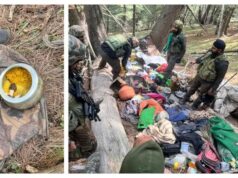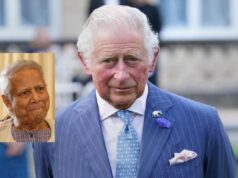Third Aircraft Carrier Most Essential For The Indian Navy
 By
By
Colonel Awadhesh Kumar, Special Forces Veteran
The real decisive battle with the Chinese will not be fought in Arunachal, Sikkim or Ladhak but in the Indian Ocean Region. So the Indian Navy rightly envisages its force structure centered around three aircraft carriers.
One carrier each with Eastern and Western Fleets ,while one Carrier when not in refit and maintenance , will be patrolling as a Carrier Battle Group, to Counter the PLAN, right at the Choke points around Java Sea and Timor sea if not off the Vietnamese Coast itself.
The proposed third carrier or the Indigenous Aircraft Carrier (IAC)-II, should be displacing around 65,000 tonnes, conventionally powered ( if designing its nuclear reactor will take time ) and a steam-launched catapult for launching and recovering aircraft.
Since 1962, India’s military plans are focused on defending the Line of Actual Control (LAC) and dominate and prevent infiltration along the Line of Control (LoC). So no wonder the defence and strategy formulators steeped in the past are questioning the need of a third aircraft carrier, sighting the budgetary constraints. They keep forgetting that those who managed to subjugate India for nearly 200 years, had come via the Indian Ocean and not the Himalayas. The Zamurin of Calicut got defeated by just six Poruguese Ships with cannons ! Rest is history . Not to be repeated .
The immediate requirement is to have a strong expanded Navy, a modernization and expansion of the Air Force and mechanization of the Army and in that order of priority.
The infrastructure along the Himalayas have been improving steadily. What the Army now needs is more fire power in terms of medium guns, rocket artillery systems, Cruise missiles and integral heli lift.
These are being added in a systematic manner. The Rafael will add muscle to IAF and the Tejas will provide the much required numbers. IAF also needs AWACS and Refuellers in adequate numbers as force multipliers along with a few squadrons of heavy lift aircrafts. These are all in pipeline or under consideration and will be done systematically .
The Navy now requires to project power in the Indian Ocean Region (IOR), keep it under 24×7 surveillance and degrade enemy ships when required. For this we do require at least three aircraft carriers. This can be accomplished by a combination of deft financial planning.
The number of smaller ships, submarines, good information, Surveillance and Reconnaissance (ISR) and missile systems have also to be increased, keeping in mind that the size of the Indian Exclusive Economic Zone is nearly as big as the Indian land mass.
With impending budget cuts, Chief of Defence Staff (CDS) Gen. Bipin Rawat had not questioned the very need of the third aircraft carrier as many have deduced wrongly.
He just said that naval aviation assets can be utilised on land borders when not utilised at sea. This is nothing new. It was done in both 1965 and 1971 and that is how Admiral Arun Prakash had won his Vir Chakra flying with the IAF.
In 1965, Seahawk aircraft of the No. 300 Naval Air Squadron were ‘working up’ at jamnagar and were placed under the operational control of the Air Force on September 2 for offensive action against the enemy.
All Naval air squadrons – the No. 300 Seahawk fighter squadron, No. 310 Alize antisubmarine aircraft squadron, No. 550 Seahawk and Alize trainer squadron and No. 551 Kiran jet trainer squadron -were made operational for reconnaissance and antishipping roles and for the air defence of Indian seaports.
Chinese are behind us by more than 50 years in Naval Aviation . However China had already decided to invest in its third aircraft carrier right after it had deployed Liaoning , a resurrected air craft carrier and while constructing its first indigenous aircraft carrier. Its force modernisation, which began in 1978, focused on military and developed capabilities to strengthen it which could settle land borders, which they have done successfully except with two nations, India and Vietnam. They are now focusing on generating sea power and air power as they are moving towards becoming a global power.
With several big ticket acquisitions lined up, Indian Navy sources had recently said they are undertaking a fleet optimisation measures with focus on adopting unmanned platforms. However, the Navy is also firm on the need for both a third aircraft carrier and the next line of six advanced submarines under Project-75I.
With the Finance Minister announcing several measures to support domestic defence manufacturing and also reduce the import bill, the Government needs to take steps to reduce heavy imports of weapon systems. This will save a lot of foreign exchange and create jobs in the country.
DRDO has to revamp itself with more intensive research and development in tune with the Services futuristic requirements. Defence PSUs too have to be streamlined and made fully accountable to the Services and to the Nation.
Making a Navy takes a long time as it takes several years to construct just one ship. we have an immediate requirement of a large Navy to fulfil our geo-political aspirations like securing IOR, Sea Lanes of Communication (SLOCS) and counter China. With investment of much time and resources, we have been able to construct our first indigenous aircraft carrier.
This expertize cannot be and should not be wasted away. As soon as possible, the keel of the IAC2 should be laid down and construction commenced. Finances required to be spent will be spread over nearly seven years and more. So with deft financial planning this can be done without much problem.
India in the past has been land centric while grappling with Pakistan and China along the land borders. This must get reoriented, now while maintaining vigil on land, we need to focus our attention towards the Indian Ocean. The fledgling Indian Navy had started with a bang in 1947 itself with Junagadh operations.
A task force under Captain RD Katari comprising three frigates and one LST.Their task was to land a few infantry companies at Porbandar, Veraval and Mangrol and also provide logistic support to the involved infantry brigade.
The Navy saw its next action in 1961 while capturing the Anjidiv island of Goa and damaging a Portuguese destroyer.
In 1965 Indian Navy was confined to the barracks because of lack of strategic awareness at Higher levels of those providing Politico Military Directions of War.
The Karachi harbour attack in 1971 was executed by missile boats but we in future require air craft carriers to block the PLAN at the Choke points around Sunda Strait itself or for barging into the Indo Pacific..




